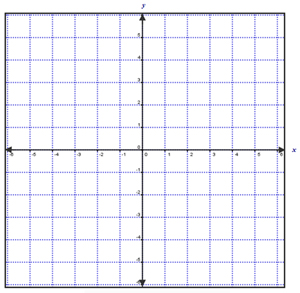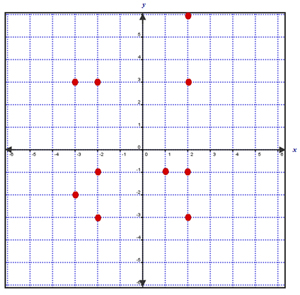
If a line contains the points (4, -1) and (-4, 3), which of the following points also lies on the line?

A. (3, 2)
Incorrect. Did you draw a line between the points?
B. (1, 0)
Incorrect. Did you count rise and the run?
C. (-1, 1)
Incorrect. Did you use an interactive tool to plot the points?
D. (-2, 2)
Correct! What process did you use to find the right point?
Which point on the number line is closest to √15?
A. point A
Incorrect. You may have divided 15 by 2, but you needed to use a calculator to find the decimal representation of the square root of 15.
B. point B
Correct! You knew that the square root of 15 was close to the square root of 16 which is 4, so it's approximate answer was close to 4.
C. point C
Incorrect. Remember the square root of a number will never be negative.
D. point D
Incorrect. Remember the square root of a number will never be negative.
Which ordered pairs form the vertices of a right isosceles triangle?

A. (2, 3), (-2, -1), (2, -1)
Correct! You understand the properties of right isosceles triangles.
B. (-2, -3), (2, 3), (2, -3)
Incorrect. While this is a right triangle, it is not isosceles…remember isosceles means that two sides of the triangle must be the same length.
C. (-3, -2), (1, -1), (2, 3)
Incorrect. While this is an isosceles triangle, it is not right…remember right triangles have one angle that is 90 degrees.
D. (-3, 3), (2, 6), (2, 3)
Incorrect. While this is a right triangle, it is not isosceles…remember isosceles means that two sides of the triangle must be the same length.
If hexagon ABCDEF is rotated around the origin 180 degrees, where would point D appear?

A. Quadrant I
Incorrect. Quadrant I is where point D was before being rotated.
B. Quadrant II
Incorrect. The hexagon could have rotated 60 degrees counter clockwise to goeto point D into Quadrant II.
C. Quadrant III
Correct! You understand how figures are rotated 180 degrees.
D. Quadrant IV
Incorrect. The hexagon could have rotated 60 degrees clockwise to go to point D into Quadrant IV.
Given the coordinates of 3 vertices of a rhombus, determine the coordinates of the missing vertex, P.
M (-3, 5), N (2, 3), O (-1, 0), P (?, ?)
A. (4, -2)
Correct! Did you use a coordinate grid to determine the right answer?
B. (4, 2)
Incorrect. You may have missed a negative sign.
C. (2, -4)
Incorrect. You may have mixed up the x and y coordinates.
D. (-4, -2)
Incorrect. Your x coordinate should be positive.